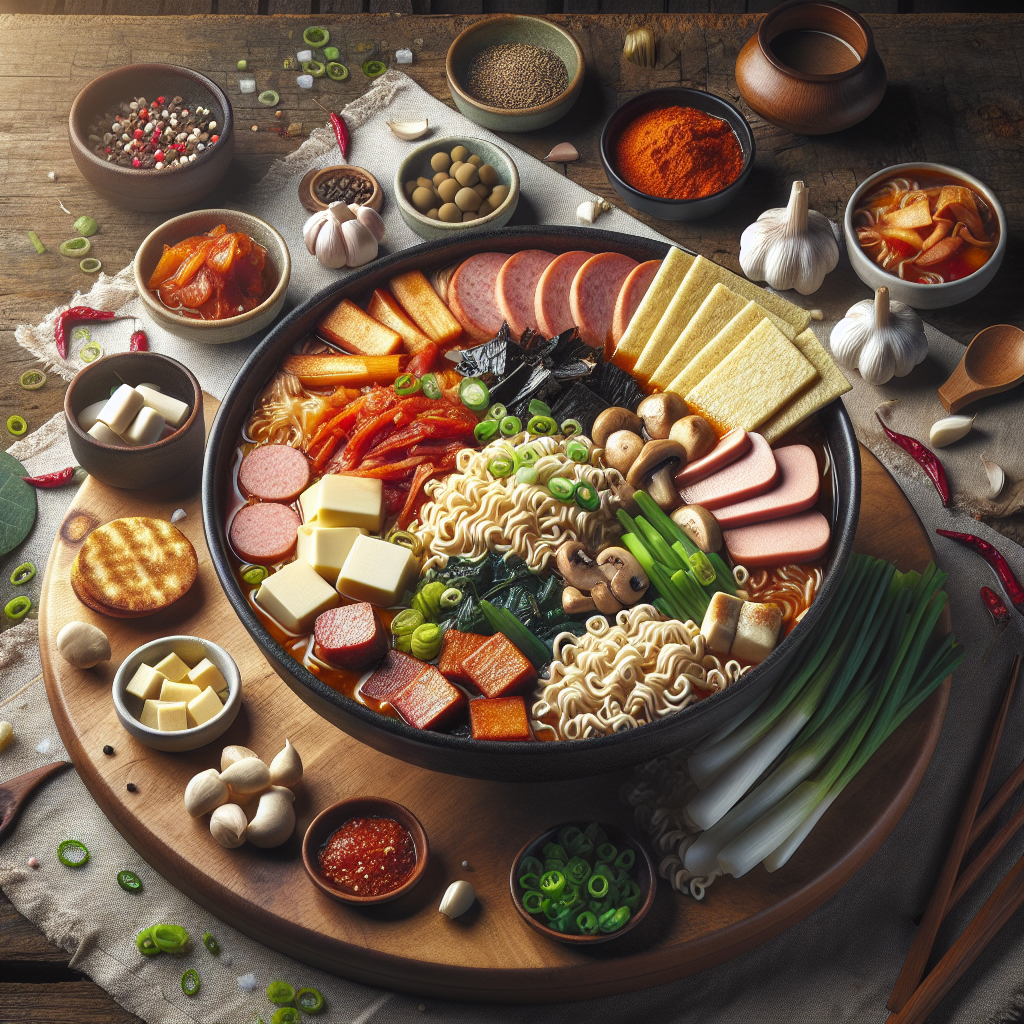
Experience the ultimate Korean-American fusion dish that emerged from post-war creativity. This hearty, spicy, and soul-warming Army Stew (Budae Jjigae) combines Spam, kimchi, and ramen in a rich, flavorful broth that's perfect for cold evenings or group gatherings.
Ingredients for Authentic Korean Army Stew (Budae Jjigae) - A Fusion Comfort Classic
- 12oz Spam
- 16oz Kimchi
- 7oz Korean Rice Cakes (Tteok)
- 2packets Instant Ramen Noodles
- 10.5oz Tofu
- 3 tbsp Korean Red Pepper Paste (Gochujang)
- 1 tbsp Korean Red Pepper Flakes (Gochugaru)
- 6 cloves Garlic
- 4stalks Green Onions
- 7oz Mushrooms
- 4 slices American Cheese Slices
- 34oz Chicken Stock
- 2 tbsp Soy Sauce
Instructions for Authentic Korean Army Stew (Budae Jjigae) - A Fusion Comfort Classic
- Slice 12oz spam into 1cm thick pieces. Cut 10.5oz tofu into cubes and slice 7oz mushrooms.
- In a large pot, combine 34oz chicken stock, 3 tbsp gochujang, 1 tbsp gochugaru, and 2 tbsp soy sauce. Mince 6 cloves garlic cloves and add to the broth.
- Bring to a boil, then arrange the spam, 16oz kimchi, tofu, and mushrooms in sections around the pot.
- Add 7oz rice cakes and instant ramen noodles (discard the seasoning packets). Simmer for 5-7 minutes until noodles are almost done.
- Place 4 slices cheese slices on top and cover until melted. Chop 4stalks green onions and sprinkle on top before serving.
Journey into the Heart of Korean Army Stew (Budae Jjigae)
Welcome to one of the most fascinating stories in fusion cuisine - Korean Army Stew, or Budae Jjigae. This hearty one-pot wonder perfectly embodies the resilience and creativity of post-war Korea, combining American military base ingredients with traditional Korean flavors. As a chef who grew up straddling two culinary worlds, this dish holds a special place in my heart, representing the beautiful marriage of Eastern and Western ingredients.
Budae Jjigae starts with a rich, spicy broth made from chicken stock and gochujang (Korean red pepper paste), loaded with an eclectic mix of ingredients - from Spam and American cheese to traditional rice cakes and kimchi. The result is a bubbling pot of comfort that serves 4 hungry souls, taking just 15 minutes to prep and 35 minutes to cook. It's the perfect example of how necessity truly is the mother of invention in the culinary world.
Expert Tips for Perfect Budae Jjigae Every Time
The secret to exceptional Korean Army Stew lies in the details. First, don't skip the step of properly arranging ingredients in sections - this isn't just for aesthetics. It allows each component to cook perfectly while making it easier for diners to choose their favorite items. When adding the gochujang and gochugaru, remember to taste as you go - different brands vary in spiciness.
For the spam, I recommend lightly searing it before adding it to the stew to enhance its flavor and texture. When it comes to the ramen, add it only in the final few minutes to prevent it from becoming too soft. The tofu should be added in larger cubes so it doesn't break apart too easily in the bubbling broth.
A pro tip: don't throw away the kimchi juice if your kimchi is well-fermented - add a splash to the broth for an extra depth of flavor. And while American cheese slices might seem unusual, they're crucial for that authentic taste and creamy texture that makes this dish so comforting.
Serving Your Korean Army Stew with Style
Budae Jjigae is best served family-style, bubbling hot right in the pot it was cooked in. Traditionally, it's enjoyed with a bowl of steamed rice on the side, which helps balance the spiciness and adds substance to the meal. Each person should get their own small bowl for eating, and communal chopsticks and a ladle should be provided for serving.
For an authentic Korean dining experience, serve this dish with a few simple banchan (side dishes) - some quick cucumber kimchi or pickled radishes work wonderfully. Don't forget to provide individual sauce dishes of extra gochujang for those who want to adjust the heat level to their liking.
A Taste of Two Cultures: My Budae Jjigae Story
My first encounter with Budae Jjigae was during a chilly autumn evening at my grandmother's house in Los Angeles. She told me stories of how this dish emerged in Uijeongbu, near U.S. military bases in South Korea, where surplus American ingredients met Korean culinary ingenuity. As she carefully arranged the Spam and kimchi in the pot, she explained how this dish represented survival, creativity, and eventually, celebration.
Growing up as an Asian-American chef, I've always been drawn to dishes that tell stories of cultural intersection. Budae Jjigae perfectly embodies this fusion, and I've made it countless times in my professional kitchen. Each time I prepare it, I'm reminded of that evening in my grandmother's kitchen, watching the cheese melt into the spicy broth, creating that distinctive taste that's neither fully Korean nor American, but something uniquely its own.
Smart Substitutions for Your Korean Army Stew
As someone who's made countless pots of Budae Jjigae, I understand that not everyone has access to traditional Korean ingredients or might need to accommodate different dietary preferences. Here are some thoughtful substitutions that won't compromise the soul of this beloved fusion dish:
For the Korean ingredients:
- Gochujang (Korean Red Pepper Paste): Mix 1 tablespoon miso paste with 1 tablespoon sriracha sauce and 1/2 teaspoon sugar
- Gochugaru (Korean Red Pepper Flakes): Use regular red pepper flakes, but start with half the amount
- Korean Rice Cakes: Skip them entirely or use thick udon noodles
- Kimchi: While it's a key ingredient, you can use sauerkraut with a dash of hot sauce for a similar tangy-spicy profile
For the protein components:
- Spam: Use ham, turkey spam, or even sliced turkey for a leaner option
- Tofu: Substitute with more mushrooms, tempeh, or additional meat protein
- American Cheese: Use any mild melting cheese like mozzarella or provolone
For the base ingredients:
- Chicken Stock: Vegetable or beef stock work well
- Mushrooms: Any variety works - shiitake, button, or cremini
- Instant Ramen: Any brand works, or use fresh noodles if preferred
- Green Onions: Chives or thinly sliced regular onions can work in a pinch
Remember, Budae Jjigae was born from creativity and making do with available ingredients, so don't be afraid to experiment while keeping the spirit of this wonderful fusion dish alive.
Nutrition Facts and Health Benefits of Korean Army Stew
Each hearty serving of Budae Jjigae (approximately 2 cups/475ml) contains:
- Calories: 580
- Protein: 32g
- Carbohydrates: 55g
- Fat: 28g
- Sugar: 8g
While Army Stew isn't typically considered a "health food," it offers several nutritional benefits. The protein content is substantial, thanks to the combination of Spam, tofu, and cheese. The kimchi provides probiotics and beneficial bacteria for gut health, while the mushrooms offer important nutrients like vitamin D and B vitamins.
To make this dish more nutritionally balanced, you can:
- Add more vegetables like spinach or bok choy
- Use less processed meat and more tofu
- Opt for low-sodium stock
- Include more mushrooms for added nutrients
- Consider using whole grain or vegetable-based noodles
Remember that this dish was created during times of scarcity, and today we can make mindful choices while still honoring its heritage.
Allergy Awareness and Dietary Restrictions
For those with dietary concerns, here's what you need to know about Korean Army Stew:
Common Allergens Present:
- Soy (in tofu, soy sauce)
- Dairy (American cheese)
- Wheat (ramen noodles)
- Possible fish/shellfish (check stock ingredients)
This dish can be adapted for various dietary restrictions:
- Gluten-Free: Use rice noodles and tamari instead of soy sauce
- Dairy-Free: Omit cheese or use dairy-free alternatives
- Vegetarian: Replace Spam with plant-based meat alternatives
- Low-Sodium: Use low-sodium stock and reduce soy sauce
Always check ingredient labels carefully, especially for:
- Store-bought kimchi (may contain fish sauce or shrimp paste)
- Gochujang (may contain wheat)
- Stock (may contain various allergens)
Storage and Reheating Guidelines for Budae Jjigae
Proper storage is crucial for maintaining the quality and safety of your Korean Army Stew:
Fresh Storage:
- Refrigerate within 2 hours of cooking
- Store in an airtight container
- Keeps for 3-4 days in the refrigerator (39°F/4°C or below)
Freezing:
- Not recommended for the complete dish
- Noodles and rice cakes become mushy
- If necessary, freeze the broth separately without noodles
- Frozen broth lasts up to 3 months
Reheating:
- Stovetop: Preferred method, heat slowly while stirring
- Microwave: Heat in 1-minute intervals, stirring between
- Add fresh noodles or rice cakes when reheating
- Adjust consistency with additional stock if needed
Frequently Asked Questions About Korean Army Stew
Q: Can I make this less spicy? A: Yes, reduce or omit the gochugaru and adjust the gochujang to taste. Start with half the amount and adjust as needed.
Q: Why is cheese in a Korean dish? A: The American cheese is a reflection of this dish's post-war origins, when American military ingredients were commonly used. It adds a creamy richness that's now traditional.
Q: Can I prep this in advance? A: You can prepare the ingredients and broth base separately up to a day ahead, but add the noodles and rice cakes just before serving.
Q: How do I know when it's done? A: The stew is ready when the noodles are tender, the cheese is melted, and the broth has slightly reduced - typically 5-7 minutes after adding the noodles.
Q: Is this authentic Korean food? A: Budae Jjigae is authentic Korean-American fusion cuisine, developed after the Korean War using available ingredients from American military bases.
A Warm Conclusion to Your Army Stew Adventure
As a chef who grew up straddling two culinary worlds, Budae Jjigae holds a special place in my heart. This dish beautifully represents how necessity and creativity can birth something truly extraordinary. It's more than just a meal - it's a historical artifact in a pot, telling the story of Korean resilience and ingenuity.
Whether you're making this for a cozy night in or sharing it with friends, remember that Army Stew is meant to be adaptable and forgiving. Don't stress too much about perfect authenticity - after all, this dish was born from making do with what was available. The most important ingredients are the warmth and comfort it brings to your table.
For the best experience, gather your loved ones around a bubbling pot of Budae Jjigae, share some stories, and create your own memories with this remarkable fusion dish. After all, that's what comfort food is all about - bringing people together and warming both body and soul.
